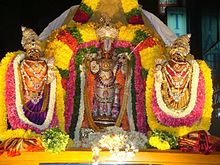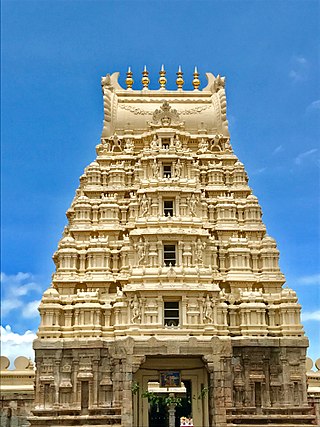
Srirangapatna is a town and headquarters of one of the seven Taluks of Mandya district, in the Indian State of Karnataka. It gets its name from the Ranganthaswamy temple consecrated around AD 984. Later, under the British rule, the city was renamed to Seringapatnam. Located near the city of Mandya, it is of religious, cultural and historic importance.
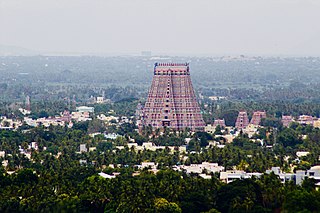
Srirangam is a neighbourhood in the city of Tiruchirappalli in the Indian state of Tamil Nadu. A river island, Srirangam is bounded by the Kaveri River on one side and its distributary Kollidam on the other side. Considered as the first among the 108 Divya Desams, a group of Vishnu temples, it is famous for the Sri Ranganathaswamy Temple, the largest temple complex in India and the biggest functioning Hindu temple in the world. Srirangam is also home to a significant population of Sri Vaishnavas.

Perumal or Tirumal is a Hindu deity. Perumal is worshipped mainly among Tamil Hindus in South India and the Tamil diaspora, who consider Perumal to be a form of Vishnu.
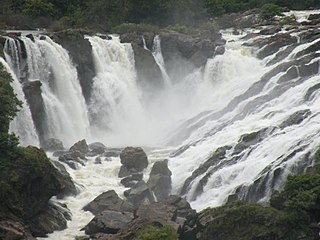
Shivanasamudra Falls is a cluster of waterfalls on the borders of Malavalli, Mandya and Kollegala, Chamarajanagara, in Karnataka, India, situated along the river Kaveri. The falls form the contour between the districts of Chamarajanagara and Mandya. The Bharachukki Falls in Kollegala, with a height of 69 metres, and the Gaganachukki Falls in Malavalli, with a height of 90 metres, collectively form the Shivanasamudra Falls.

Ranganathaswamy Temple is a Hindu temple dedicated to Ranganatha and is located in Srirangam, Tiruchirapalli, Tamil Nadu, India. Constructed in the Dravidian architectural style, the temple is glorified by the Tamil poet-saints called the Alvars in their canon, the Naalayira Divya Prabhandam, and has the unique distinction of being the foremost among the 108 Divya Desams dedicated to the god Vishnu. The Srirangam temple is the largest temple compound in India and is one of the largest religious complexes in the world. Some of these structures have been renovated, expanded and rebuilt over the centuries as a living temple. The latest addition is the outer tower that is approximately 73 metres (240 ft) tall, it was completed in 1987. Srirangam temple is often listed as the largest functioning Hindu temple in the world, the still larger Angkor Wat being the largest existing temple. The temple is an active Hindu house of worship and follows the Tenkalai tradition of Sri Vaishnavism. The annual 21-day festival conducted during the Tamil month of Margali (December–January) attracts 1 million visitors. The temple complex has been nominated as a UNESCO World Heritage Site, and is in UNESCO's tentative list. In 2017 the temple won the UNESCO Asia Pacific Award of Merit 2017 for cultural heritage conservation, making it the first temple in Tamil Nadu to receive the award from the UNESCO.
Ranganatha Temple or Ranganathaswamy Temple may refer to any of several temples dedicated to the Hindu God Ranganatha, including:

Ranganayaki, also known by her epithet Tayar, is a Hindu goddess. She is the presiding goddess of the Sri Ranganathaswamy temple at Srirangam. She is the chief consort of Ranganatha, the tutelary deity of Srirangam. The goddess is regarded as a manifestation of Lakshmi, while Ranganatha is considered as a manifestation of Vishnu. She is also called Ranganayaki Nachiyar and Periya Piratti.

Ucchi Pillayar Temple is a 7th-century-CE Hindu temple, one dedicated to Lord Ganesha located a top of Rock Fort, Trichy, Tamil Nadu, India. According to legend, this rock is the place where Lord Ganesha ran from King Vibishana, after establishing the Ranganathaswamy deity in Srirangam. Tiruchirapalli Rock Fort is also fondly called as Malaikottai in Tamil.

The Srivilliputhur Andal Temple in Srivilliputhur, a town in Virudhunagar district in the South Indian state of Tamil Nadu, is dedicated to the Hindu god Vishnu. It is located 80 km from Madurai. Constructed in the Dravidian style of architecture, the temple is glorified in the Nalayira Divya Prabandham, the early medieval Tamil canon of the Alvar saints from the 6th–9th centuries CE. It is one of the 108 Divya Desams dedicated to Vishnu, who is worshipped as Vatapatrasayi and his consort Lakshmi as Andal. It is believed to be the birthplace of two of the Alvars, namely Periyalvar and his foster-daughter, Andal.

The Ranganathaswamy temple or Sri Ranganathaswamy temple in Srirangapatna, in the Mandya district of Karnataka state, India, is dedicated to the Hindu god Ranganatha. The temple is Classified one among the 108 Abhimana Kshethram of Vaishnavate tradition. It is one of the five important pilgrimage sites of Sri Vaishnavism along the river Kaveri for devotees of Ranganatha. These five sites are collectively known as Pancharanga Kshetrams in South India. Since Srirangapatna is the first temple starting from upstream, the deity is known as Adi Ranga. The town of Srirangapatna, which derives its name from the temple, is located on an island in the river Kaveri.

The Sri Ranganthaswamy temple in Shivanasamudra, Kollegala taluk, Chamarajanagara district, Karnataka, India is a temple dedicated to the Hindu God Ranganatha, a manifestation of Vishnu. While there are numerous Ranganatha temples in South India, and many of those are located along the banks of river Cauvery, there are three temples within the islands that are formed within the river itself. The temple is one of a such three major temples that are built on three different islands on the River Kaveri, the others being those at Srirangapatna and Srirangam.

Vaikhanasa or Vaikhanasagama is a tradition of Hinduism that primarily worships Vishnu as the Supreme God. The tradition draws its name from the philosophy propounded by its founder, Sage Vikhanasa.

Azhagiya Manavalan Perumal Temple in Uraiyur, a suburb Tiruchirappalli in the south Indian state of Tamil Nadu, is dedicated to the Hindu god Vishnu. Constructed in the Dravidian style of architecture, the temple is glorified in the Divya Prabandha, the early medieval Tamil canon of the Alvar saints from the 6th–9th centuries AD. It is one of the 108 Divyadesam dedicated to Vishnu, who is worshipped as Azhagiya Manavalan and his consort Lakshmi as Kamalavalli.

Appakkudathaan Perumal Temple or Thirupper Nagar, is a Hindu temple located in Koviladi, a village 10 miles (16 km) from Tiruchirapalli, Tamil Nadu, India. It is dedicated to Vishnu and is one of the Divya Desams—the 108 temples of Vishnu revered in Nalayira Divya Prabandham by the 12 poet saints or Alvars. This temple is located along the banks of the Cauvery River and is one of the five Pancharanga Kshetrams located on the banks of the Cauvery River.
Tiruppan Alvar was one of the twelve Alvars of South India, who were poet-saints known for their affiliation to the Sri Vaishnava tradition of Hinduism. The verses of the Alvars are compiled as the Naalayira Divya Prabandham and the 108 temples revered in the text are classified as Divya Desams. Tiruppan Alvar is considered the eleventh in the line of the twelve Alvars.

The Pancharanga Kshetrams or Pancharangams is a group of five sacred Hindu temples, dedicated to Ranganatha, a form of the deity Vishnu, on the banks of the Kaveri River. The five Pancharanga Kshetrams in the order of their successive locations, on the banks of the Kaveri River are:
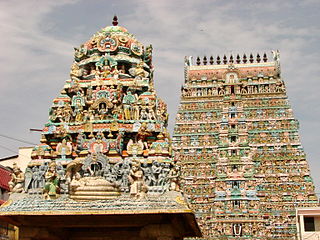
The Sarangapani Temple is a Hindu temple dedicated to Vishnu, located in Kumbakonam, Tamil Nadu, India. It is one of the Divya Desams, the 108 temples of Vishnu revered in Nalayira Divya Prabandham by the 12 poet saints, or Alvars. This temple is along Kaveri and is one of the Pancharanga Kshetrams.

Sthalasayana Perumal Temple is a Hindu temple dedicated to the god Vishnu located near Kollumangudi, Tamil Nadu, India. It is located 2 km away from Kollumangudi, 40 km away from Kumbakonam and 10 km from Karaikal. Constructed in the Dravidian style of architecture, the temple is glorified in the Nalayira Divya Prabandham, the early medieval Tamil canon of the Alvar saints from the 6th–9th centuries CE. It is one of the 108 Divya Desams dedicated to Vishnu, who is worshipped as Sthalasayana Perumal and his consort Lakshmi as Thirumagal Nachiyar. A granite wall surrounds the temple, enclosing all the shrines. There is a four-tiered rajagopuram, the temple's gateway tower, in the temple.

Parimala Ranganathar Perumal Temples or Tiruindaloor is a Hindu temple dedicated to Vishnu, located in Thiruvilandur of Mayiladuthurai, a town in the South Indian state of Tamil Nadu. It is one of the Divya Desams, the 108 temples of Vishnu revered in Nalayira Divya Prabandham by the 12 poet saints, or the Alvars. This temple is along Kaveri and is one of the Pancharanga Kshetrams.

Adhirangam Ranganathaswamy temple or Ranganatha Perumal Temple is a Hindu temple dedicated to Vishnu located in Adhi Thiruvarangam in the Taluk of Sankarapuram, Tamil Nadu, India. Constructed in the Dravidian style of architecture, it is believed to have been built by the Medieval Cholas and Vijayanagar kings. It covers an area of 5 acres (20,000 m2) and has a historical grain storage container. It is classified one among the 108 Abhimana Kshethram of Vaishnavate tradition.
